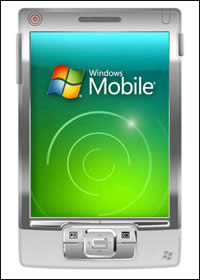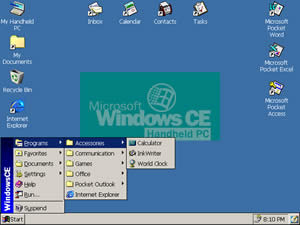Difference between Windows Mobile and Windows CE
Key Difference: Windows Mobile is a family of operating systems on smartphones and pocket PCs. Windows Mobile has been discontinued by the company, with the final version of Windows Mobile being 6.5.5. Windows CE is a real-time operating system for embedded systems by Microsoft. It is also known as Windows Embedded Compact, Windows Embedded CE or WinCE.
Windows Mobile and Windows CE are two different types of operating systems for different devices. Windows Mobile is a family of operating systems for mobile phones, while Windows CE is a family of operating systems for embedded systems.

Windows Mobile is a family of operating systems on smartphones and pocket PCs. Windows Mobile is the predecessor of Windows Phone, which is the latest series of operating systems for smartphones. Windows Mobile has been discontinued by the company, with the final version of Windows Mobile being 6.5.5. Windows became popular mainly in pocket PCs, which allowed businessmen to maintain their daily appointments, add appointments, access the internet and some even allowed users to make phone calls. Windows Mobile was based on the Windows CE kernel and was introduced as the Pocket PC 2000 operating system. The system was designed to resemble the desktop version of the PC, making it more familiar to people. Windows Mobile offered software applications from the Windows Marketplace.
Windows Mobile had many features such as: multitasking, ability to navigate a file system, Internet Explorer Mobile, Windows Media Player, Microsoft Office Mobile, Outlook Mobile and Internet Connection Sharing. The device came with stylus capabilities and had resistive touch technology, which required a stylus for input. Many devices also made it easier to navigate and type by introducing slideout keyboards or keypads.
 Windows CE is a real-time operating system for embedded systems by Microsoft. It is also known as Windows Embedded Compact, Windows Embedded CE or WinCE. This operating system is basically a shell that Windows licenses to device makers, who then add their own components such as UI, device drivers, applications and so on. The CE becomes a base on which the customers build their own devices and software. An embedded system is basically a computer system that has a function within a larger mechanical or electrical device. These systems can be housed on a single microprocessor board. Embedded systems are used in consumer electronics, transportation systems, medical equipment, safety and security applications, etc. The current version of Windows CE supports platforms such as x86, MIPS, ARM and (SuperH up to 6.0 R2). These operating systems are designed for device that have limited amount of storage. Devices can even be configured without disk storage as a ‘closed’ system.
Windows CE is a real-time operating system for embedded systems by Microsoft. It is also known as Windows Embedded Compact, Windows Embedded CE or WinCE. This operating system is basically a shell that Windows licenses to device makers, who then add their own components such as UI, device drivers, applications and so on. The CE becomes a base on which the customers build their own devices and software. An embedded system is basically a computer system that has a function within a larger mechanical or electrical device. These systems can be housed on a single microprocessor board. Embedded systems are used in consumer electronics, transportation systems, medical equipment, safety and security applications, etc. The current version of Windows CE supports platforms such as x86, MIPS, ARM and (SuperH up to 6.0 R2). These operating systems are designed for device that have limited amount of storage. Devices can even be configured without disk storage as a ‘closed’ system.
Using CE requires developmental tools such as: Platform Builder, Free Pascal and Lazarus, Visual Studio, Embedded Visual C++, CodeGear Delphi Prism, AutoHotkey, LabView, Basic4ppc, CodeGear Delphi Prism and GLBasic. The company’s latest release was the Windows CE 7.0 and was launched in March 2011. Wikipedia lists the changes in the newest version as: Multi-core CPU support (SMP), Wi-Fi Positioning System, Bluetooth 3.0 + HS support, DLNA (Digital Living Network Alliance), DRM technology, Media Transfer Protocol, Windows Phone 7 IE with Flash 10.1 support, NDIS 6.1 support, UX C++ XAML API using technologies like Windows Presentation Foundation and Silverlight for attractive and functional user interfaces, Modernized graphics based on OpenGL ES 2.0, Advanced touch and gesture input, Kernel support for 3 GB physical RAM and supports ARMv7 assembly.
|
|
Microsoft Mobile |
Windows CE |
|
Company/ Developer |
Microsoft |
Microsoft |
|
Programmed in |
C++ |
C |
|
OS family |
Windows |
Windows CE |
|
Initial release |
April 19, 2000 |
November 16,1996 |
|
Supported platforms |
x86 |
x86, MIPS, ARM, (SuperH up to 6.0 R2) |
|
License |
Proprietary (Microsoft EULA) |
MS-EULA |
|
Default user interface |
Graphical |
Microsoft licenses the software to OEMs, who are then are free to create their own UIs. |
|
Working state |
Discontinued (Replaced by Windows Phone) |
Current |
|
Source model |
Licensed software |
Closed-sourced licensed software |
|
Updates |
Updates are only done by Microsoft. |
Updates are only done by Microsoft. |
|
Applications |
Applications are created by tie up companies and Microsoft. |
Does not require applications. |
|
Touch style |
Stylus-centric, but newer phones offer capacitive technology. |
Advanced touch and gesture input. |
|
Offers native support for |
Mail, Exchange, Outlook Contacts, Calendar, etc. |
- |
|
Number of applications |
Limited number of applications. |
- |
|
Language support |
Limited language support |
Multilingual |
Image Courtesy: raybiztech.com, geektrio.net









Add new comment